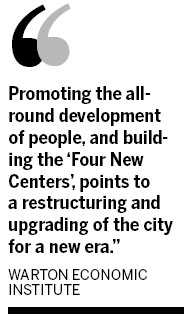
New research is suggesting a marked shift is needed in Shanghai's future priority industry sectors if the city is ever to achieve its goal of becoming one of the world's top international cities.
The study, from Shanghai-based Warton Economic Institute, said city officials need to change the city's previous strategy of building international centers, or its "Four Centers", for economy, trade, finance and shipping, and set new targets that add more, what it calls, "people-oriented elements".
Revealing the findings exclusively to China Daily, Shen Hanyao, the president of Warton, said four new centers need to be established, prioritizing the economy, science and education, culture and entertainment, and medical treatment and health.
"Promoting the all-round development of people, and building the 'Four New Centers', points to a restructuring and upgrading of the city for a new era," the report suggests.
Its findings reveal Shanghai's GDP rose by 8.2 percent year-on-year to hit 1.92 trillion yuan ($304 billion) in 2011, or $12,784 per capita, close to developed economies' levels.
But some of its key sectors are already reaching saturation point, and the city is running short of staff members in some key areas, the report warns.
It recommends that the city, along with its neighbors such as Wuxi (with per capita GDP of $17,000), Suzhou ($17,000) and Kunshan ($20,000) in Jiangsu province, need to switch their development focus from meeting basic material needs of its residents, to improving the overall quality of life, improving science, education and culture levels, and diversifying leisure and entertainment options.
The Four Centers idea takes into account the strategic repositioning of the city in an new era when many expect China will gradually replace the United States to become the world's largest economy, the report said.
Shen added that Shanghai's potential as a truly world force has already been noticed by a growing number of global business heavyweights.
The latest example is FedEx Express Corp, one of the world's largest express transportation companies, which announced plans together with the Shanghai Airport Authority recently to build a brand new international express and cargo hub at Shanghai Pudong International Airport.
Its arrival in Shanghai, along with cargo facilities already in place there run by global rivals DHL and UPS, make Pudong International the first airport to feature the presence of the world's three major logistics operators, said officials.
The new hub is expected to meet FedEx's requirements for 20 years and beyond.
However, Shen said that the city's development momentum is not encouraging under the current Four Centers economic blueprint.
Most of its key industries are already facing saturation point and staff levels in the culture, education and medical treatment sectors particularly are facing critical shortages.
Although Shanghai still enjoys advantages compared with its neighboring cities, it is less competitive than other global metropolises, he added.
"Those issues mean we have to consider looking at the Four Centers plan."
He said science and education are especially crucial in raising any city's competitiveness.
"Any country without a world-class science and education center can never become a world economic center," he noted.
He pointed out that after World War II, the US, for example, gathered the world's best scientists and set up the Stanford University-Silicon Valley model, which was aimed at commercializing top research.
The practice immediately transformed the US into the world's leading science and education market, and secured its dominance of high-end scientific research.
Shen added that universities and laboratories are still birthplaces of frontier science and technology.
And for Shanghai to not only compete, but take a lead, it has to pay attention to building itself into not only a world economic center, but also one that plays host to a world-class science and education community.
The Four Centers blueprint also means remaining an international manufacturing and financial center, and expanding the city's historic role as a key shipping, transport and trade hub home to some of the world's top transport businesses.
The Shanghai International Port (Group) Co Ltd, for instance, became the world's busiest container port by processing 31.74 million 20-foot equivalent units, or containers, in 2011.
But Shen's plan doesn't come cheap.
To build culture, science and education, medical research and treatment centers, and possibly other facilities for the development of the city's creative industry, could require up to 1 trillion yuan in investment for each sector.
But he added, the massive spending will generate huge business opportunities, jack up domestic demand, spur the regional economy, and greatly improve the city's attraction as a tourism destination.
Shen said it was possible to build an internationally acclaimed science and education center, for example, within one to two decades.
He highlighted that Tsinghua University, founded in 1911, won international fame in about 10 years.
The National Southwestern Associated University, established in 1938 but disintegrated in 1946, became one of the most prestigious universities in China's history in only eight years, with a handful of leading scientists including Nobel Prize winner of Tsung-Dao Lee and Chen-Ning Yang being educated there.
The key to building the Four New Centers is reform, opening-up, and innovation, he stressed. "We need to further open our doors to the world's best education organizations, medical treatment centers, and entertainment companies."
Updated: 2012-10-30 10:40
By Xu Taotao in Shanghai ( China Daily)